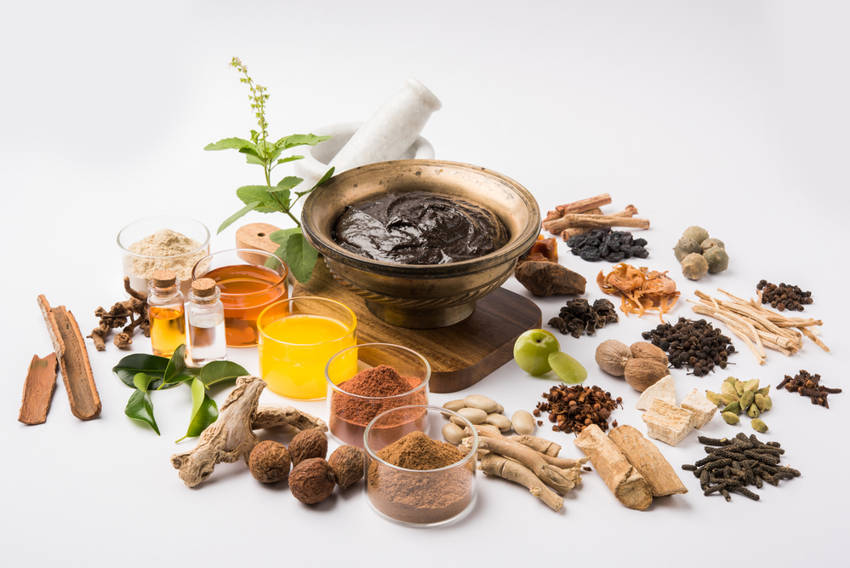Ayurvedic herbs are an option for those who prefer natural treatments over conventional, western ones.
But what are they, and their benefits? We introduce you to a few Ayurvedic herbs that are safe to consume and teach you the best ways to prepare them.
About Ayurvedic Medicine
Ayurveda has the distinction of being the world’s oldest holistic, natural healing systems. It took root in India 3000 years ago.
Those who practice Ayurvedic Medicine believe that harmony between a person’s mind, body, and spirit determines a person’s wellness. They maintain that every person consists of the five elements – space, air, water, fire, and earth. These elements connect and become three life forces or energies.
Ayurvedic practitioners aim to promote holistic health, which they think will block disease. These are Pitta Dosha (fire and water) Vata Dosha (fire and water), and Kapha Dosha (water and earth).

Everyone has a mix of these Doshas, and one of them is usually more potent than the others. Each manages a different body function. A balance between them minimizes the risk of illness.
Vata Dosha
This Dosha is the most potent of the three. It manages body functions like how cells divide. It also controls a person’s mental faculties, breathing, heart function, and bowel regulation. You’re more likely than others to develop anxiety, heart disease, asthma, and skin problems if this is the strongest of your life forces.
Pitta Dosha
This life force controls your digestion and metabolism. It also regulates the hormones linked to appetite. Eating sour or spicy foods can disrupt this dosha. You’re likely to develop conditions like Chron’s Disease, Heart Disease, and High Blood Pressure if this is your life force.
Kapha Dosha
This Dosha regulates muscle growth, strength, weight, and immunity. Sleeping during the day disrupts this dosha, as does eating too many sweets. You may develop asthma if this is your primary life force.
Benefits of Ayurvedic Herbs for Health
First of all, the breathing techniques advocated by Ayurvedic practitioners play a huge part in reducing anxiety. The National Center for Complementary and Integrative Health states that they are natural treatments for many conditions, including stress.
1. Weight Loss
Losing weight isn’t a primary concern of Ayurveda. However, it does promote weight loss because it encourages a healthy diet. Female yoga practitioners found that it does help them shed pounds.
2. Balances Hormones
Ayurvedic herbs support natural hormone balance, which results in a natural menstrual cycle. This study shows that it balances hormones which is a boon in the fight against prostate cancer.
3. Reduce inflammation
Poor sleep, an inadequate diet, and poor digestion can lead to inflammation. Ayurveda reduces inflammation, regulates the cardiovascular system, and clears the digestive tract. Taking in herbs boosts metabolism and releases antioxidants.
Indeed, Ayurvedic herbs reduce the symptoms of illnesses like arthritis because they encourage a person to eat healthily. Some metals, for example, have healing properties that keep diseases away.
4. Cleanses
Panchakarma, or natural cleansing, is a common Ayurvedic practice. It is the process of getting rid of food and toxins that interfere with the efficient functioning of the body. Ayurvedic massage and oils help to promote holistic health.
5. Cures Sleeplessness
Late dinners and drinking coffee before bed can disrupt your sleep and nervous system. Ayurvedic herbology induces rest. Rubbing jasmine or coconut oil on the feet helps to promote sleep, as does drinking a cup of warm milk. Ayurvedic sleep therapy, or Shirodhara, is a useful tool in the fight against insomnia.
6. Regulates Bloat
Ayurvedic herbs rid the body of waste buildup. Spices like cumin and cardamom are solutions for indigestion. Chewing cumin and gum promotes digestion, as does drinking fennel in boiled water.
7. Healthy Skin
Ayurveda keeps the skin soft and radiant. The best part about an Ayurvedic skincare regime is that it doesn’t cost the user much. The purifying properties and high water content of cucumber, lettuce, and daikon make them ideal for skincare.
10 Ayurvedic Herbs and How to Use Them for Different Health Problems

Ayurveda is the most developed herbal system in the world. Ancient Vedic seers classified herbs and their healing properties into a herbal healing system that anyone can access. We introduce you to a few of these herbs.
1. Ajwain
First of all is Ajwain, a potent digestive, and nerve stimulant. It draws toxins that have seated themselves deeply in the body. This herb also heals painful joints.
What health problem does it treat?
Because it acts as a digestive and purges toxins, Ajwain is perfect for weight loss. You can take it as a tea to help youshed pounds. All you have to do is boil it with 16 ounces of water.
2. Ashwagandha
This herb enhances vitality and helps those who suffer from too much stress. Since it’s fat soluble, it can go deep into the tissues.
What health problems does it treat?
People who take this herb do so to slow down the aging process. They also do so to relieve stress. Half a teaspoon of them, cooked in milk, go a long way.
3. Brahmi
Also known as Bacopa, Brahmi is a creeping herb that grows in Eastern India. You’ll find it in the marshy areas of Nepal, China, Pakistan, and Nepal.
What does it treat?
Brahmi heals the brain and nervous system. Its leaves even look like brain synapses. It is especially useful for balancing Pitta conditions. Brahmi improves a person’s cognition and memory.
4. Curcumin
Also on this list is Curcumin, a bright yellow substance that the Curcuma longa plant produces. It is a rhizome, like other members of the ginger family. It has natural phenols that make it bright yellow.
What does it treat?
This Ayurvedic herb is a potent remedy for inflammation, arthritis, depression, and indigestion. It also eases the symptoms of PMS and other inflammatory conditions. This review proves its benefits for health.
5. Triphala
This herb has three myrobalans, or herbs, in equal parts. Researchers haven’t discovered much about this plant, but they do know that it has gallic acid, chebulagic acid, and Chebulinic acid, which are responsible for its health effects.
What does it treat?
This herb is said to treat constipation, digestive problems, diabetes, eye disease, and root canal problems.
6. Amla
Also known as the Indian Gooseberry, this is a fruit of a deciduous tree. It’s light greenish-yellow and has six clear, vertical stripes. Farmers harvest them by hand. According to Buddhist tradition, it was a gift to the Indian Emperor Ashoka.
What does it treat?
This herb will help you if you have the flu. It protects the immune system. Cancer patients use it in conjunction with chemotherapy to relieve their symptoms.
7. Boswellia
You may know this herb as Frankincense. It produces a chemical we know as resin. There are different grades of it, depending on its harvesting. Boswellia plants have a reputation for being able to grow in harsh environments.
What does it treat?
Boswellia treats inflammation and arthritis. It also relieves hay fever, sore throat, menstrual cramps, stomach pain, and acne.
8. Holy Basil
Holy Basil is an aromatic perennial plant native to India. It is a favorite among farmers in Southeast Asia. Farmers drink it with herbal tea. It’s also a common ingredient in essential oils.
What does it treat?
Holy Basil is an Ayurvedic remedy for the flu. It treats respiratory ailments like asthma, stress, and allergies.
9. Neem
Also known as Indian Lilac, Neem belongs to the mahogany family of plants. You will find it on the Indian Subcontinent, Nepal, Bangladesh, and Pakistan.
What does it treat?
Neem is a powerful natural treatment for fungal, bacterial, and viral diseases. It is a popular treatment for shingles. Do be careful when taking it because it may drive your blood pressure too low.
10. Rauwolfia
You may recognize this evergreen plant as Devil Peppers. A member of the Dogbane family, it is a favored plant in Latin America, Asia, and Africa.
What does it treat?
Rauwolfia treats high blood pressure. It makes the walls elastic and restores healthy blood flow.
Try Ayurvedic medicine the next time you feel the flu developing. You’ll treat not only your ailment but also gain holistic health.





Hi mam, you have done a wonderful work. Even as Indian i know few of these.
Thank you! I am glad you found these useful.